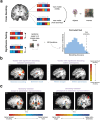This is a preprint.
The Neural Underpinnings of Aphantasia: A Case Study of Identical Twins
- PMID: 39386622
- PMCID: PMC11463508
- DOI: 10.1101/2024.09.23.614521
The Neural Underpinnings of Aphantasia: A Case Study of Identical Twins
Update in
-
The neural underpinnings of aphantasia: a case study of identical twins.Cereb Cortex. 2025 Jul 1;35(7):bhaf192. doi: 10.1093/cercor/bhaf192. Cereb Cortex. 2025. PMID: 40698973
Abstract
Aphantasia is a condition characterized by reduced voluntary mental imagery. As this lack of mental imagery disrupts visual memory, understanding the nature of this condition can provide important insight into memory, perception, and imagery. Here, we leveraged the power of case studies to better characterize this condition by running a pair of identical twins, one with aphantasia and one without, through mental imagery tasks in an fMRI scanner. We identified objective, neural measures of aphantasia, finding less visual information in their memories which may be due to lower connectivity between frontoparietal and occipitotemporal lobes of the brain. However, despite this difference, we surprisingly found more visual information in the aphantasic twin's memory than anticipated, suggesting that aphantasia is a spectrum rather than a discrete condition.
Keywords: Visual imagery; fMRI; functional connectivity; long-term memory; perception.
Figures






References
Publication types
Grants and funding
LinkOut - more resources
Full Text Sources
Research Materials
